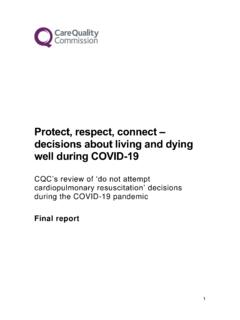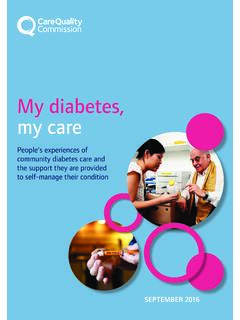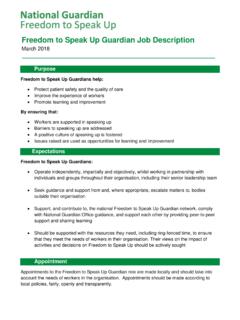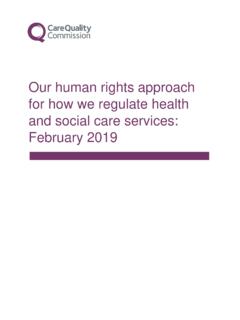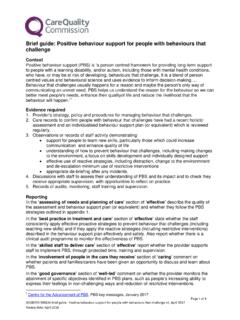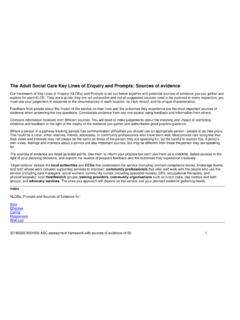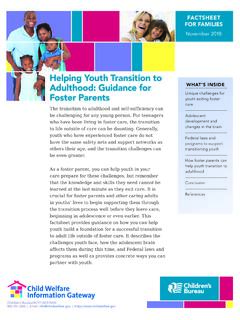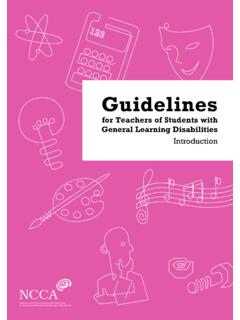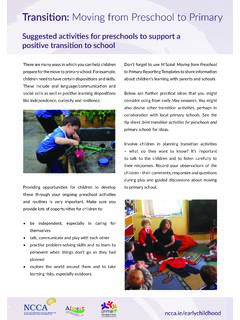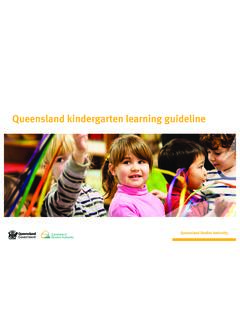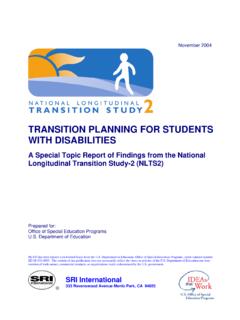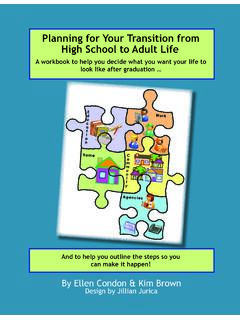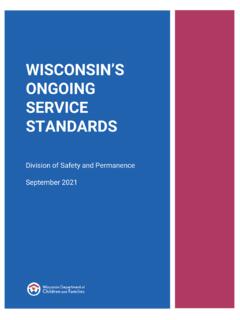Transcription of From the pond into the sea - CQC
1 01 From the pond into the sea: Children s transition to adult health servicesJune 2014 Fromthe pondinto the seaChildren s transition to adult health servicesFrom the pond into the sea: Children s transition to adult health servicesIllustration by a graphic artist who captured the views of young people and their parents at one of our focus the pond into the sea: Children s transition to adult health servicescontENTSF oreword 2 Summary 4 Introduction 131. The transition process 182. Funding/budget 263. transition plan 304. Involvement and choice 345. Carers 406. Di erent health settings 427. Training for professionals 538. Transfer to adult services 569. Integrated / holistic care 60 Conclusions and recommendations 66 Acknowledgments 71 References 722 From the pond into the sea: Children s transition to adult health services2 From the pond into the sea: Children s transition to adult health servicesI was frustrated and upset when I read this report, though unfortunately I was not surprised.
2 It is not about incompetent doctors, uncaring nurses or remote social workers; on the contrary the vast majority of them are highly competent, care deeply and desperately want to help. No, this report describes a health and social care system that is not working, that is letting down many desperately ill youngsters at a critical time in their lives. We have put the interests of a system that is no longer fit for purpose above the interests of the people it is supposed to serve. The system is fragmented, confusing, sometimes frightening and desperately di cult to navigate. Too o en instead of helping young people and their parents it adds to their despair. It need not be like we set out to understand the experiences of these young people and their families we saw some wonderful examples of good transition planning , especially in specific health specialities (cardiac, diabetes or cystic fibrosis services).
3 This shows it can be done. There is plenty of guidance on what makes for good transition planning and good commissioning of care. But we found a significant shortfall between policy and practice. For young people, their families and sometimes the sta caring for them this creates confusion and frustration. Even worse, young people can find themselves without essential care or equipment because of the di erent ways services are provided, or while funding arrangements are resolved. In 2013 the Government asked organisations to pledge to do everything they can to improve the care of children and young people, and the Care Quality Commission (CQC) was happy to sign up to this. One of the five shared ambitions in that pledge was that services will be joined-up and care will be coordinated around the individual to ensure the best possible experience of transition to adult services for those young people who need ongoing the pond into the sea: Children s transition to adult health services3 From the pond into the sea: Children s transition to adult health servicesHowever, through this review it has become clear to us that a system-wide change is needed to achieve a joined-up approach.
4 Each part of the system, at every level, needs to work together. I hope that, together, the changes that the Care Act 2014 has made and the recommendations contained in this report will achieve the change and improvement that has been clearly needed for a long time. planning must start early, and funding responsibilities should be clear. Adult and children s services should work together and information must be shared routinely so that young people and their parents don t waste precious time repeating information about their health. Young people must not fall in the gap between children s and adult services. Medical advances and better care mean that more children with serious illnesses and disabilities are surviving into adulthood. There is a powerful argument to make sure that now, more than ever, care for these young people is integrated and coordinated around their needs and the needs of their families.
5 We believe there needs to be an urgent review of how these services are commissioned, and that commissioners must listen more e ectively to young people and their families and deliver better, more e ective, joined-up services. During this review we have listened to and learned from children and young people, and we pledge to involve them in our inspections. When we find good and outstanding care, we will celebrate it. We will encourage improvement where we find it is needed and we will not hold back when we find inadequate care that is not meeting the needs of our children and young people. Professor Steve FieldChief Inspector of Primary Medical Services and Integrated Care4 From the pond into the sea: Children s transition to adult health servicesSummaryYoung people face plenty of challenges when preparing for adult life.
6 For the 40,000 children and young people with complex physical health needs, there are many additional hurdles. In many cases, the health needs of these young people will have been met by the same people who have looked a er them for as long as they can remember. However, one of the changes as they reach adulthood is the transfer to an adult environment where they may need to consult several di erent health teams, therapy teams, and adult social care services. Over the last two decades, there has been much guidance about this process, o en referred to as transition . Of central importance to the coordination of transition is the transition plan. This plan should start at 14 years of age, or even earlier. The guidance sets out the responsibilities of individual health professionals and the need for a named person as the key coordinator for health.
7 It stresses the importance of good working arrangements between di erent health and care services. As part of our review, we spoke to 180 young people, or parents of young people, between the ages of 14 and 25 with complex health needs. We found that the transition process is variable and that previous good practice guidance had not always been implemented. Young people and families are o en confused and at times distressed by the lack of information, support, and services available to meet their complex health needs. It is not acceptable to find, as we did, parents and young people caught up in arguments between children s and adult health services as to where care Only 50% of young people and their parents said they had received support from a lead professional during the process leading up to transition to adult services.
8 This report describes a health and social care system that is not working, that is letting down many desperately ill youngsters at a critical time in their lives. We have put the interests of a system that is no longer fit for purpose above the interests of the people it is supposed to serve. Professor Steve Field, Chief Inspector of Primary Medical Services and Integrated Careshould be provided. Or to find that a care service just stops when children s service ends but before the adult service commences. Or to hear from a care worker that transition was well-coordinated, but only because mother is proactive in coordinating professionals and will actively seek help if needed .From the pond into the sea: Children s transition to adult health servicesFrom the pond into the sea: Children s transition to adult health services5 Case study: PeterPeter s experiences are typical of those faced by many of the young people and families we talked has cerebral palsy.
9 Throughout his childhood, his developing needs presented continuing challenges to Peter and his family. Family life became centred around Peter s needs: physiotherapy, hydrotherapy and hospital visits, both locally and to specialist centres further afield. Because of his complex needs, there is a lot of moving and handling and medical equipment to support him at home. Peter has to be fully supported in his wheelchair; he is registered blind and unable to speak. He is unable to care for himself and relies on his family and carers for all his day-to-day needs. Peter has a good memory and sense of humour, he recognises those close to him and enjoys going to his special school where he is a day student. Peter enjoys company and responds to questions in his own way using facial expressions and his body language.
10 He enjoys trips out, going to his local church, having a lie-in (school days start at ) and listening to needs support from healthcare sta who are competent to feed him through the tube into his stomach, as he cannot eat or drink through his mouth. Breathing problems mean he sometimes needs emergency care and he also needs care from physiotherapists, occupational therapists and speech and language had a coordinator for his health needs who was a paediatrician and worked with Peter and his family to ensure that all the specialist health services he needed were available and working Peter was 14 his parents received a letter that mentioned transition as part of the annual review that is a mandatory requirement for anyone with a Statement of Special Educational Needs.
